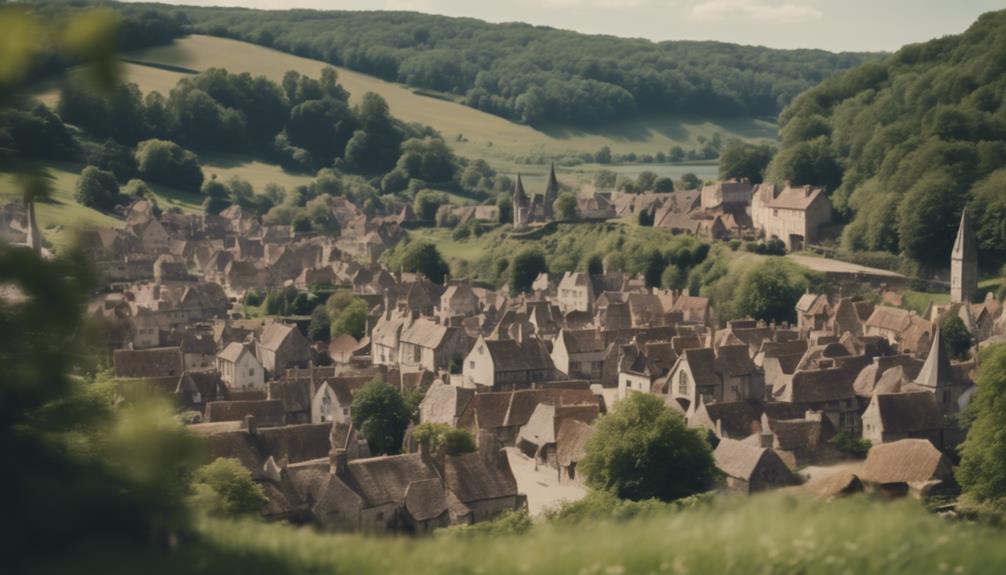Exploring Shropshire's Rich Cultural Heritage Sites
Explore Shropshire's heritage by visiting the Roman City of Wroxeter, where you'll see ancient ruins and artefacts. Walk along Offa's Dyke, an 8th-century earthwork, stretching 150 miles. Marvel at Old Oswestry Hillfort, one of Britain's best-preserved Iron Age forts. Discover medieval wonders at Ludlow Castle and picturesque Stokesay Castle. Step back in time at Iron Bridge, the world's first cast iron bridge. Acton Burnell Castle offers a glimpse into early parliamentary history. Experience Victorian life at Blists Hill Victorian Town with candle dipping and blacksmithing. There's so much more to uncover across Shropshire's historic sites.
Key Points
- Explore ancient ruins and Roman artifacts at the Roman City of Wroxeter.
- Stroll along Offa's Dyke, an 8th-century boundary and defense structure.
- Visit Old Oswestry Hillfort, one of Britain's best-preserved Iron Age forts.
- Admire the world's first cast iron bridge, the UNESCO-listed Iron Bridge.
- Immerse yourself in Victorian life with interactive exhibits at Blists Hill Victorian Town.
Roman City of Wroxeter
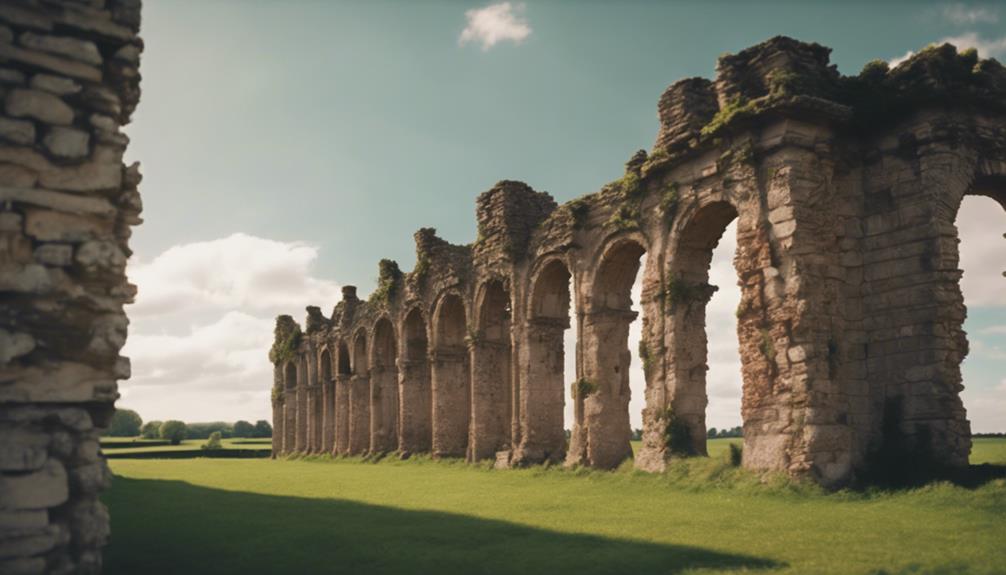
One of the most captivating sites you'll explore in Shropshire is the ancient Roman city of Wroxeter. Located just five miles southeast of Shrewsbury, Wroxeter was a bustling Roman hub from the 1st to the 5th centuries AD. As you walk through the site, you'll feel a connection to the past through the impressive ancient ruins and the abundance of Roman artefacts on display.
Wroxeter boasts some fascinating structures unearthed through meticulous excavations. You'll marvel at the remains of the grand bath house complex, a central part of Roman social life. The forum colonnade, once a bustling marketplace, gives you a glimpse into the daily activities of Roman citizens. Temples that once stood proudly as places of worship now offer an insight into the spiritual lives of the ancient inhabitants.
Managed by English Heritage, Wroxeter's archaeological site provides a rare window into Roman Britain. The well-preserved artefacts and ruins here tell a story of a thriving community, offering you a chance to step back in time.
Visiting Wroxeter, you'll not only see history but also become part of a community that values and preserves its rich heritage.
Offa's Dyke
After exploring the Roman city of Wroxeter, you'll find another remarkable historical landmark in Shropshire: Offa's Dyke. This ancient earthwork boundary, attributed to King Offa of Mercia in the 8th century, runs along the England-Wales border. Spanning approximately 150 miles from the North Wales coast to the Severn Estuary, Offa's Dyke holds immense geographical significance.
Its construction is believed to serve a dual purpose: territorial demarcation and defence. As you walk along the Dyke, imagine the cultural evolution and historical moments that have unfolded here. The Dyke wasn't just a boundary; it was a statement of power and influence. By marking the territory, King Offa aimed to fortify his kingdom against Welsh incursions, showcasing a strategic defensive strategy.
Today, Offa's Dyke attracts hikers, historians, and nature enthusiasts alike. When you walk its length, you're not just traversing a path but connecting with centuries of history. You belong to a lineage of explorers seeking to understand the past.
The landscape here tells a story of resilience and demarcation, making Offa's Dyke a must-visit on your Shropshire adventure.
Old Oswestry Hillfort
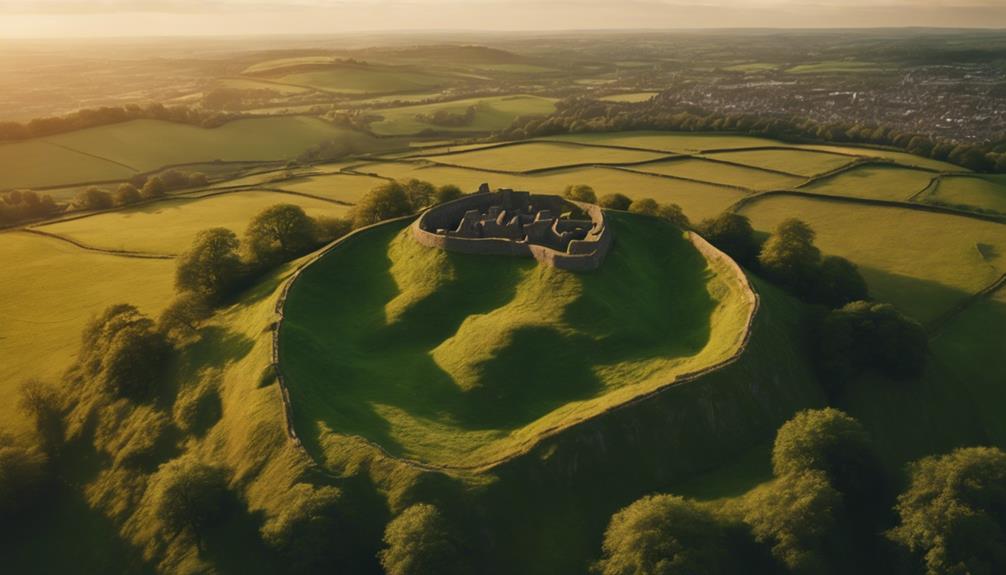
When you visit Old Oswestry Hillfort, you're stepping into one of Britain's best-preserved Iron Age defensive structures. The purpose of its intricate earthworks remains a mystery, fuelling much archaeological debate.
Managed by English Heritage, this site not only offers a glimpse into ancient history but also breathtaking panoramic views of Shropshire's landscape.
Ancient Defensive Structures
Old Oswestry Hillfort, often celebrated as the best-preserved Iron Age hill fort in Britain, stands as a tribute to ancient defensive ingenuity. When you visit, you'll be stepping into a world of Iron Age mysteries, with its impressive earthworks and strategic location.
The significance of these earthworks remains unclear, adding to the site's intrigue. Walking along the ramparts, you can almost feel the history beneath your feet.
Preservation efforts are vital here. The site is owned by Shropshire Council and managed by English Heritage, ensuring its protection for future generations. Community advocacy plays a significant role too, especially as the hillfort faces threats from nearby housing developments. This collective effort shows a shared commitment to safeguarding a piece of your heritage.
As you explore, you'll appreciate the fort's strategic defensive location. It was designed to offer expansive views of the surrounding landscape, providing early settlers with a prime vantage point against potential invaders.
Being part of this heritage site, you'll feel a connection to those ancient times, understanding how our ancestors ingeniously harnessed natural features for their defence. It's a place where the past feels vividly present, inviting you to discover more.
Archaeological Significance Uncovered
Delving into the archaeological significance of Old Oswestry Hillfort, you'll uncover layers of history that reveal the complexities of Iron Age society. This site, located in Shropshire, stands as one of the best-preserved Iron Age hill forts in Britain, providing a fascinating glimpse into a bygone era.
The ancient earthworks at Old Oswestry are an enigma, with their true purpose still a subject of debate among experts, adding to the Iron Age mysteries surrounding this archaeological wonder.
Owned by Shropshire Council and managed by English Heritage, the hillfort is meticulously preserved to safeguard its historical integrity. However, it's under threat from nearby housing developments, sparking efforts to petition for its protection. Your visit supports these preservation endeavours, helping to uphold this significant cultural heritage site for future generations.
As you explore the hillfort, you'll be immersed in the remnants of Iron Age life, walking the same paths that ancient peoples once trod. The site's archaeological wonders offer a window into the past, sparking curiosity and a sense of belonging to a shared human history.
Your journey through Old Oswestry Hillfort isn't just a step back in time but a step towards preserving our collective heritage.
Panoramic Views Experience
Standing atop Old Oswestry Hillfort, you'll be treated to breathtaking panoramic views of the Shropshire Plains and the Welsh hills. This vantage point offers an unforgettable experience, allowing you to immerse yourself in the natural beauty of the region.
Whether you're planning sunset picnics or simply soaking in the breathtaking vistas, the hillfort is the perfect spot.
For those who love birdwatching, the scenic overlooks provide an excellent opportunity to observe a variety of bird species in their natural habitat. The expansive earthworks and defensive ramparts, dating back to around 800 BC, also add a sense of historical wonder to your visit.
To fully appreciate Old Oswestry Hillfort, consider these activities:
- Sunset Picnics: Enjoy a relaxing evening with a picnic as the sun sets, casting a golden glow over the landscape.
- Birdwatching: Bring your binoculars and spot different bird species from the scenic overlooks.
- Photography: Capture the breathtaking vistas of the Shropshire Plains and Welsh hills.
- Historical Exploration: Walk around the extensive earthworks and imagine the hillfort's ancient past.
Old Oswestry Hillfort is a place where you can connect with nature, history, and the local community.
Shrewsbury Flaxmill Maltings
Shrewsbury Flaxmill Maltings, one of the world's first iron-framed buildings, is undergoing a remarkable multi-million pound restoration to preserve its historical significance. This site stands as a tribute to the Industrial Revolution, showcasing the early use of iron in construction. The restoration project is more than just a facelift; it's a dedication to heritage preservation, ensuring future generations can appreciate this pioneering structure.
When you visit, you'll find more than history; you'll find a community. A new visitor centre will welcome you, offering insights into the site's past. Imagine relaxing in the on-site café, sipping your coffee while surrounded by the echoes of industrial innovation. The offices housed within will create a dynamic space where modern work meets historical ambiance.
The restoration efforts haven't gone unnoticed. Recognised through various awards, the project has garnered support from the National Lottery Heritage Fund, highlighting its cultural importance. By visiting, you're not just exploring a building; you're becoming part of a larger story. Your presence and interest help breathe new life into this iconic site, ensuring its legacy endures.
Iron Bridge
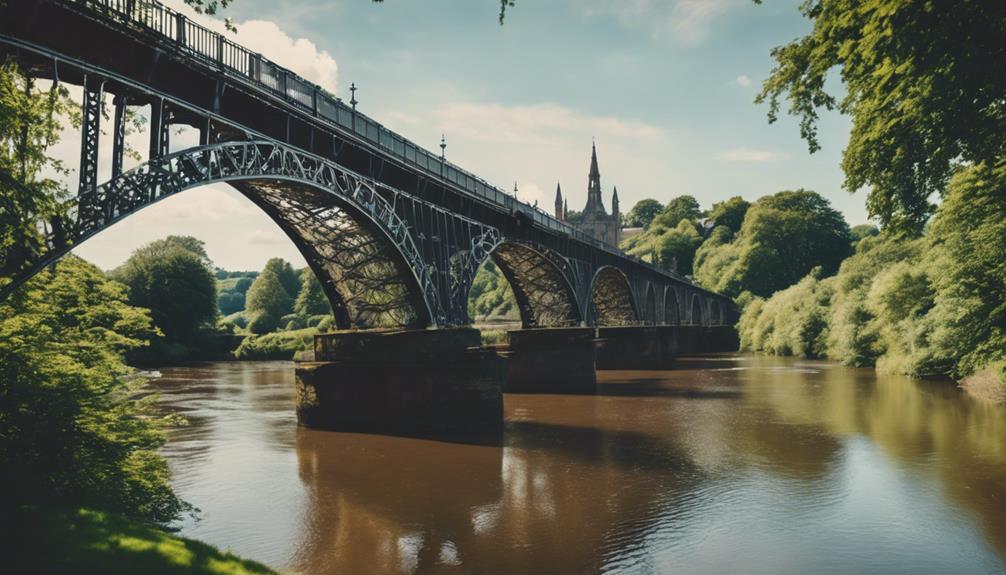
Among the engineering marvels of the 18th century, Iron Bridge in Telford, Shropshire, stands out as the world's first cast iron bridge and a symbol of the Industrial Revolution. This iconic structure isn't just a bridge; it's a demonstration of industrial progress and technological innovation. When you visit, you'll be stepping into a piece of history that influenced future engineering and architectural practices.
Managed by the Ironbridge Gorge Museum Trust, the site preserves a wealth of historical artefacts and archives from the period. Walking across the bridge, you can't help but feel the weight of its significance. It's more than iron and rivets; it's an architectural marvel that showcases the ingenuity of its time.
To truly appreciate its impact, consider these points:
- World's First Cast Iron Bridge: A pioneering achievement that changed engineering forever.
- UNESCO World Heritage Site: Recognised globally for its role in industrial progress.
- Technological Innovation: Demonstrates the advancements that fuelled the Industrial Revolution.
- Architectural Influence: Set a standard for future constructions, blending functionality with beauty.
Ludlow Castle
At Ludlow Castle, you'll discover medieval architectural wonders that highlight the fortress's historical importance.
This 11th-century fortress not only functioned as a royal dwelling but also had a significant role in the English Civil War.
While you explore, you'll reveal the historical depths that establish this castle as a pivotal part of Shropshire's abundant cultural heritage.
Medieval Architectural Marvels
Ludlow Castle, with its origins dating back to the 11th century, stands as a remarkable example of medieval architecture and history. As you stroll through this medieval fortress, you'll be captivated by the architectural marvels that define its structure. The castle's stone walls, imposing towers, and grand gatehouse offer a vivid glimpse into the past, showcasing the defensive strategies and daily life of medieval nobility.
When you visit, you'll discover four key areas that evoke a sense of wonder and connection to history:
- Great Hall: Envision grand feasts and royal gatherings in this impressive space.
- Chapel: Experience a sense of serenity and spirituality where medieval worship took place.
- Residential Quarters: Imagine the lives of nobility as you wander through their living spaces.
- Scenic Overlook: Stand in awe of the stunning views of the River Teme and the town of Ludlow below.
Exploring these areas, you'll not only appreciate the castle's historical significance but also feel connected to the rich cultural heritage of Shropshire.
Ludlow Castle isn't just a relic of the past; it's a gateway to understanding the lives and legacies of those who shaped medieval England.
Historical Significance Revealed
Venturing beyond the architectural marvels, you will discover the profound historical significance of Ludlow Castle, a site that has witnessed centuries of political intrigue and military strategy. Dating back to the 11th century, this castle was a formidable stronghold for the Marcher Lords, involved in countless battles and political maneuverings. As you stroll through its towers, walls, and the Great Hall, you will get a sense of life in medieval England.
Ludlow Castle is not just a relic of the past; it is a living history lesson. The site hosts various events and exhibitions where you can see medieval artefacts and participate in historical reenactments. These experiences bring history to life, allowing you to feel connected to the stories and people from England's past.
Here's a glimpse of what you can explore at Ludlow Castle:
| Area | Highlights |
|---|---|
| Towers | Panoramic views, defence |
| Great Hall | Medieval banquets, gatherings |
| Exhibitions | Medieval artefacts, displays |
| Events | Historical reenactments, tours |
Visiting Ludlow Castle is more than just a trip; it's a journey through time, offering a sense of belonging to England's rich historical tapestry.
Acton Burnell Castle
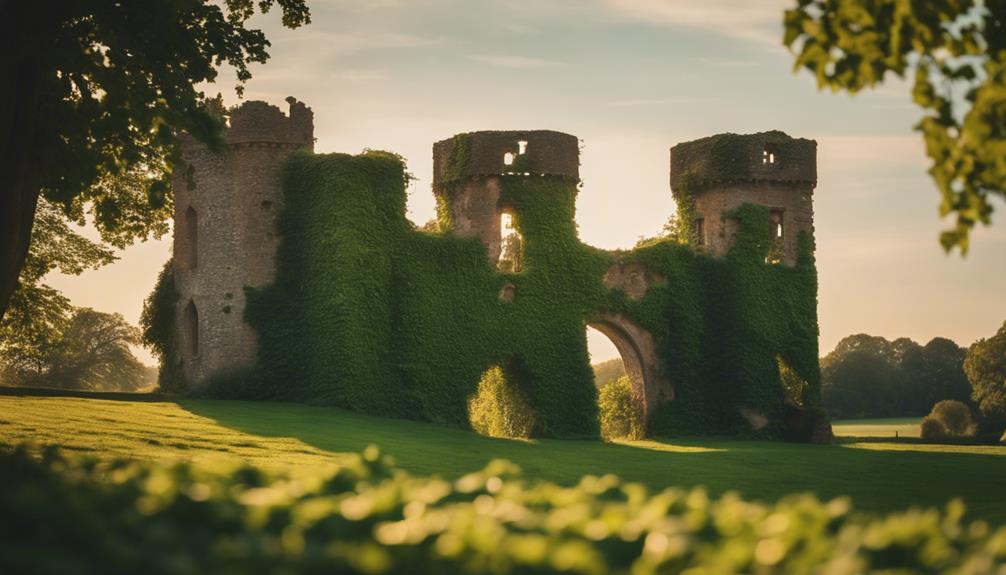
Discover the fascinating history of Acton Burnell Castle, a 13th-century fortified manor house near Shrewsbury that hosted England's first Parliament in 1283. This intriguing site stands as a testament to medieval architecture and politics. When you visit, you'll be captivated by the castle's history and architectural details. Built by Bishop Burnell, the manor features a rectangular great hall and fortified walls, offering a glimpse into medieval life.
Acton Burnell Castle isn't just about its impressive construction; its role in medieval politics is equally significant. Hosting the first Parliament in 1283, it marked a pivotal moment in English governance. Imagine standing where historic decisions were made, shaping the future of a nation.
As you explore, keep these highlights in mind:
- Historical Significance: Feel connected to history, knowing you're walking where Parliament first convened.
- Architectural Marvels: Marvel at the medieval design, from the great hall to the fortified walls.
- Educational Experience: Learn about the intricate details of medieval politics and their lasting impact.
- Community Connection: Join others who share your passion for history and heritage.
Acton Burnell Castle invites you to step back in time and be part of history.
Stokesay Castle
Step into the past at Stokesay Castle, a stunning 13th-century fortified manor house that stands as one of England's best-preserved medieval treasures. As you walk through its gates, you'll be captivated by the medieval splendour that defines this architectural treasure. The castle's great hall, with its high ceilings and intricate woodwork, offers a vivid glimpse into life during the Middle Ages.
You'll find that the tower and gatehouse are equally impressive, showcasing the defensive features that made the castle a formidable stronghold. Managed by English Heritage, Stokesay Castle not only preserves these historical elements but also brings them to life through guided tours and educational programmes. You can join a tour to hear fascinating stories about the castle's past, adding depth to your visit.
Surrounded by beautiful gardens and the picturesque Shropshire countryside, Stokesay Castle provides a serene setting for exploration and relaxation. Whether you're wandering the grounds or delving into the castle's history, you'll feel a sense of belonging to a time long gone.
Don't miss out on the events held throughout the year, which further enrich your experience and connection to this remarkable site.
Blists Hill Victorian Town
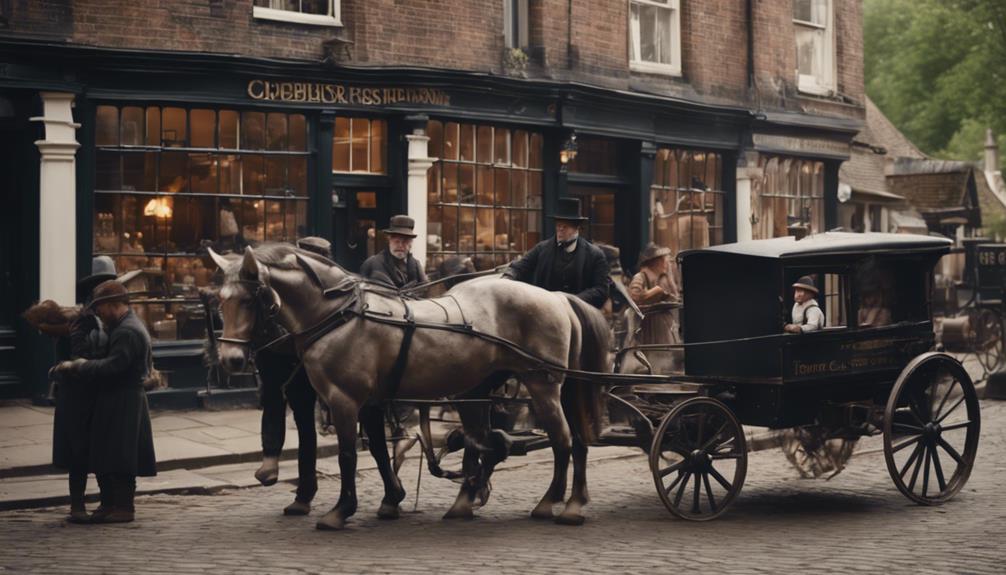
As you wander through Blists Hill Victorian Town, you'll be transported back to the 19th century, experiencing an authentic recreation of Victorian life. Located in Ironbridge Gorge, Shropshire, this open-air museum captures the essence of a bygone era with its meticulously recreated shops, houses, and industrial buildings.
The charm of Blists Hill lies in its costumed characters and interactive exhibits. These elements bring history to life, letting you feel like part of the community. You can engage in hands-on activities that give you a taste of traditional crafts and trades. Imagine yourself dipping candles, watching a blacksmith at work, or even enjoying a ride on a Victorian fairground.
Here are some activities you won't want to miss:
- Candle Dipping: Create your own candles using age-old techniques.
- Blacksmithing: Witness the skill and strength of a Victorian blacksmith.
- Fairground Rides: Experience the thrill of a Victorian-era fairground.
- Shopping in Victorian Stores: Browse through authentic Victorian shops.
Blists Hill Victorian Town offers a unique, immersive experience where you can connect with the past and feel a sense of belonging to the Victorian community.
Frequently Asked Questions
What is the Heritage Site of Telford?
You'll find Telford's heritage site in Shropshire, showcasing the legacy of the Industrial Revolution. Explore local museums and historical landmarks like the Iron Bridge and Coalbrookdale blast furnace, connecting with a community proud of its rich history.
What is the oldest World Heritage Site in the world?
The oldest World Heritage Site is the Galápagos Islands, not Göbekli Tepe or the Lascaux Caves. You'll love its unique biodiversity and pristine ecosystems that influenced Darwin's theory of evolution and continue to inspire scientific research today.
Why is Ironbridge a World Heritage Site?
Ironbridge is a World Heritage Site because it marks the birthplace of the Industrial Revolution. You'll love witnessing its architectural marvel, the first cast iron bridge, which revolutionised construction and symbolises incredible industrial progress.
What Is the Most Beautiful World Heritage Site?
You might think Stonehenge mysteries or Machu Picchu are the most beautiful, but Ironbridge Gorge truly captivates with its blend of natural beauty and industrial heritage. It's a place where history and nature create a magical experience.
Conclusion
Exploring Shropshire's rich cultural heritage sites offers you a thorough exploration of history. From the ancient ruins of the Roman City of Wroxeter to the industrial marvel of the Iron Bridge, each location tells a unique story.
You'll walk through medieval fortresses like Ludlow Castle and experience Victorian life at Blists Hill. Shropshire's diverse landmarks provide a comprehensive view of England's past, making your visit both educational and memorable.
Embrace this journey through time and discover Shropshire's treasures.
